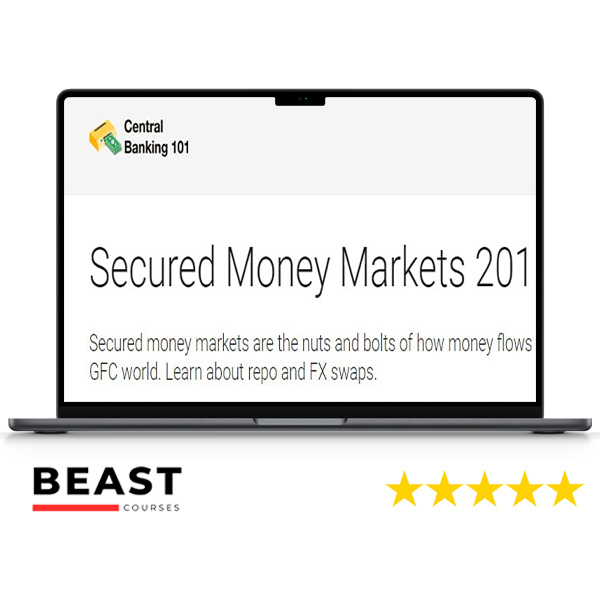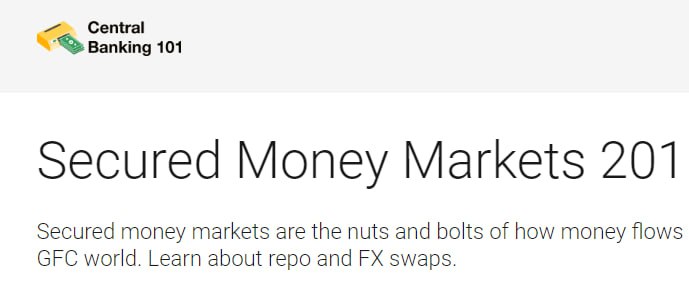Master the Mechanics of Global Finance with the Secured Money Markets 201 Course
Unlock the intricacies of the global financial system with the Secured Money Markets 201 course. Designed for professionals and enthusiasts alike, this course comprehensively explores secured money markets, focusing on the critical roles of the repo and FX swap markets.
Understand how these vital components of the financial infrastructure function, who the key players are, and why they are essential in maintaining economic stability, especially in the post-Global Financial Crisis (GFC) era.
Gain insights into the transactional mechanics, market segments, and the Federal Reserve’s involvement, equipping you with the knowledge needed to navigate these complex markets confidently.
Why Enroll in the Secured Money Markets 201 Course?
The Secured Money Markets 201 course offers an in-depth dive into the fundamental aspects of the repo and FX swap markets. It gives learners a thorough understanding of how these markets operate and their significance in the global economy. With practical examples, real-world scenarios, and expert instruction, this course is invaluable for anyone looking to deepen their understanding of the financial markets and the role of central banking.
What Are the Key Concepts Covered in the Repo Market?
The repo market is a cornerstone of the financial system, providing essential liquidity to financial institutions. This course breaks down the repo market’s complex mechanisms into easily understandable components.
- Definition and Importance: A repurchase agreement (repo) is a short-term borrowing arrangement where one party sells securities to another with the agreement to repurchase them at a higher price at a future date. This market is vital for financial institutions to effectively manage their short-term funding needs.
- Transactional Mechanics: Learn how the repo market functions, with a focus on the transactional mechanics where the seller (borrower) temporarily transfers securities to the buyer (lender) and agrees to repurchase them at a specified date and price. The difference between these prices represents the interest paid on the loan, often backed by government bonds or high-quality securities.
How Are Market Segments and Participants Defined in the Repo Market?
Understanding the different market segments and participants in the repo market is crucial for navigating its complexities.
- Market Segments: The repo market consists of two primary segments: Tri-Party Repo and Bilateral Repo. In a Tri-Party Repo, a third party, typically a clearing bank, facilitates the transaction and manages the collateral, while in a Bilateral Repo, the transaction occurs directly between two parties without an intermediary.
- Specials vs. General Collateral (GC): Explore the distinctions between Specials—repos where specific securities are in high demand, often trading at lower interest rates, and General Collateral (GC)—repos where securities are more generic and traded at standard market rates.
- Key Participants: The course covers the main participants, including dealer banks, hedge funds, asset managers, and central banks. Dealer banks are the primary participants in borrowing and lending large sums. At the same time, hedge funds and asset managers use repos to finance positions, and central banks engage in repos as part of monetary policy operations.
What Is the Role of the Federal Reserve in the Repo Market?
The Federal Reserve (Fed) plays a critical role in the repo market, particularly in managing liquidity and ensuring financial stability.
- Open Market Operations: Understand how the Fed uses repos and reverse repos to control liquidity within the banking system, influencing interest rates and overall economic stability.
- Standing Repo Facility (SRF): Learn about the Standing Repo Facility, introduced post-GFC, which allows eligible banks to access liquidity directly from the Fed. This facility is pivotal in mitigating short-term liquidity risks and maintaining market confidence.
How Does the FX Swap Market Function?
The FX swap market is another key component of the secured money markets, crucial for managing currency risk and liquidity across global financial markets.
- Definition and Importance: An FX swap involves two parties exchanging currencies and agreeing to reverse the transaction at a predetermined rate on a future date. These swaps are essential for managing currency risk and providing liquidity, particularly in market stress.
- Transactional Mechanics: Dive into the transactional mechanics of FX swaps, where a currency exchange occurs at the spot rate, followed by a reverse exchange at a predetermined forward rate. The difference between the spot and forward rates reflects the interest rate differential between the two currencies.
Who Are the Key Participants in the FX Swap Market?
The FX swap market is a dynamic space with diverse participants, each playing a specific role in maintaining market stability.
- Commercial Banks: As major players in the FX swap market, commercial banks use these instruments for liquidity management and currency risk hedging. They are often the primary facilitators of FX swaps, providing necessary liquidity and market depth.
- Central Banks and Corporations: Central banks engage in FX swaps to influence currency markets and stabilize exchange rates, especially during periods of financial stress. Corporates use FX swaps to manage exposure to foreign currency risk, particularly in international transactions.
How Does the Federal Reserve Utilize FX Swaps?
The Federal Reserve’s involvement in the FX swap market is critical, particularly during periods of financial crisis or market stress.
- Swap Lines: Learn about the swap lines established by the Fed with other central banks, designed to provide liquidity in US dollars during market distress. These swap lines help prevent disruptions in global dollar funding, ensuring smoother international financial operations.
- Crisis Management: Understand the importance of FX swaps in crisis management. During financial crises, the Fed’s FX swap lines play a crucial role in maintaining global financial stability, preventing disruptions in the availability of US dollars, which are often in high demand during market turbulence.
Why Is This Course Essential for Understanding Secured Money Markets?
How Does This Course Enhance Your Understanding of Financial Markets?
The Secured Money Markets 201 course offers a comprehensive overview of two critical markets—the repo and FX swap markets. By understanding these markets, participants can gain a deeper appreciation for how global financial systems function, especially regarding liquidity management and risk mitigation.
- Comprehensive Knowledge: Covering the repo and FX swap markets from the basics to advanced concepts, this course provides a full spectrum of knowledge, ensuring you are well-equipped to understand and engage with these markets.
- Real-World Application: Through detailed exploration of market mechanics, segments, and key participants, the course equips learners with practical knowledge to navigate these complex markets. Understanding the Fed’s involvement further underscores the importance of these markets in maintaining financial stability.
How Can This Course Benefit Your Career or Business?
By enrolling in the Secured Money Markets 201 course, you will position yourself as a knowledgeable professional in a highly specialized field. You will gain insights that are crucial for roles in finance, banking, and economic policy.
- Enhanced Decision-Making: Gain the confidence and knowledge to make informed decisions about liquidity management, currency risk, and financial stability. This course prepares you for roles that require a nuanced understanding of financial markets, such as treasury management, financial analysis, and economic policy advisory.
- Career Advancement: Stand out in the competitive financial sector by mastering complex topics like the repo and FX swap markets. With this knowledge, you can enhance your expertise, making you an invaluable asset to financial institutions, investment firms, and regulatory bodies.
Conclusion: Why Choose the Secured Money Markets 201 Course?
The Central Banking – Secured Money Markets 201 course is more than just an educational program; it’s a critical resource for anyone looking to understand the complexities of the global financial system. With a deep dive into the repo and FX swap markets, and a comprehensive overview of the role these markets play in maintaining financial stability, this course provides unparalleled insights into the world of secured money markets.
Whether you are a professional in finance, an economic policymaker, or simply a market enthusiast, this course will elevate your understanding and empower you to navigate these critical components of global finance with confidence.
Enroll today and gain the expertise to excel in the ever-evolving world of secured money markets.








